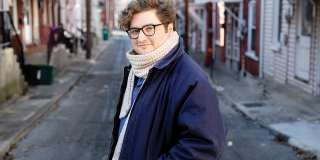
Audiences attending the off-Broadway premiere of the play House of Telescopes entered a magical world fashioned collaboratively by three Lehigh theatre faculty and an alumnus of its theatre program.
Directed by Lyam Gabel, assistant professor of theatre, the play explores the journey of Fable, a trans woman, who leaves her home in Colorado and comes to Minneapolis, searching for identity outside the constraints of their history. Pipeline Theatre’s production at ART NY Theatre in April offered an immersive world featuring set design by Lehigh scenic design professor Mellie Katakalos, projections by media design professor Joseph Amodei, and props designed by Travis Martinez ’21.
In a 2018 interview on Pipeline Theatre’s website, House of Telescopes playwright Kairos Looney said, “I initially set out to write an impossible play wherein magic is a metaphor for the queer experience.” Bringing that metaphor to life was a guiding principle for Gabel, Katakalos, Amodei, and Martinez.
Gabel, who specializes in bringing new work to the stage that often explores queer experiences, explained that using magic offers a way to access material not available using a traditional approach.
“Kairos uses magic in a very literal sense. People In the play practice magic and there also are magical happenings, such as a chorus of ancestors that follows the characters throughout the play. There is also a puppet, which is a collection of one of the main character’s childhood objects. Employing magical elements also allows the playwright to talk about things inside of the queer and trans experience that are unexplainable. There can be some truth found by talking about very complicated things using magic and images rather than dialogue,” Gabel explains.
Other themes of the play focus on relationships among chosen family and family of origin. “A lot of the play is about conflict and repair,” Gabel says. “How do we move forward together when we don't say the right thing? Or do the right thing, especially at first? That's an issue not only with trans people interacting with the cisgender world, but also trans folks interacting with each other. What does it mean to be with one another through a process of repair?”
Collaboration was key in creating the world of the play. “As a new play director, there are three kinds of collaborative teams that I'm working with on production. One is the playwright and the dramaturg. We're working together on text,” Gabel says. “And then I'm working with a team of designers on actualizing the world and discovering the mechanics of how the world operates. And then I'm working with a cast of actors on embodying the performance and figuring out how the performance moves physically in space.”
The design team included Katakalos, Amodei, and Martinez. The creative challenge in working on the world premiere of a new play – a challenge that is both freeing and daunting – is that there are no preconceived notions of how the world of the play looks. “The container of the play is what I often call it,” Katakalos states. “And that's how I explain it to my students so that they understand, yes, you're creating architecture around the play, but it doesn't have to be real. It's the container that holds it.”
The creative choices made in designing the set, such as using many doors and having the house appear as if under construction, support the play’s themes. “Lyam and I started talking, and he said, ‘Well, you know, they're building and rebuilding their identity, right?’ It’s as if they're renovating and I love that idea of renovation.... And so I thought, okay, so the container can be a like a house or an environment under construction or renovation.”
The set featured curving lines, unpainted wood and myriad doors that became entrances and exits taking characters to multiple locations, from rooftops to bedrooms. Katakalos also used a transverse stage – also called a tennis court – in which the audience sits on opposite sides of the stage, seeing the performance a bit differently depending on where they are seated.
A group of characters called cartographers help to guide the main character on their journey. They became spirit-like projections via Amodei’s creative vision. As the play’s action evolves, so does the way the projections are used. “In this play, the queer ancestors are highlighted with a colorful live video effect that tracks their movements in the more realistic settings of the play,” Amodei explains. “This gives the audience a magical way of looking at the spirits as they look at Fable and the rest of the characters. Then, as they enter each other’s worlds in a more concrete way, this type of colorful, live media effect bleeds into more of the world of the play, stitching it together.”
A new play often evolves and changes before opening night and designers must be flexible in meeting the changing needs of the production. The choice to leave some parts of the set unpainted emerged when the Amodei’s projections were more effective against bare wood. Katakalos said embracing such changes is integral to her work. “The skill of the designer is flexibility and problem solving,” she states.
Amodei agrees, adding, “In our artistic collaborations there is always a push and pull of trying to find the right timing and collaboration of elements for each moment of the story. This part of the process is quite intensive, technical, and detail-oriented to allow the flowing magic of theater to be felt by the audience.”
Problem solving also was at the heart of Martinez’s work as props designer. Martinez earned an Integrated Degree in Engineering, Arts & Sciences (IDEAS) while at Lehigh, and now works as a theatre consultant at Arup, where he designs performance spaces. House of Telescopes was his off-Broadway premiere – and one that posed some unique challenges. Being a props designer requires finding, borrowing, or creating objects that complement and match characters and the mood of the play. “My goal is to find objects that the dramaturg agrees tell the audience who these people are, what their motivation is, and where they are in their life,” Martinez says. “And similar to other design, like lighting design, most of the work is subconscious.”
Perhaps the most challenging props to locate were ten CPR dummies required for one scene. After scouring eBay and Facebook, he finally found some at an EMT training program in Pennsylvania. The program delivered the dummies to New York, where Martinez painted them in different skin tones to reflect the cultural diversity found in the cast.
It was the first time designing props for Martinez, who usually is a scenic and lighting designer. Noting that he was able to come to New York after graduating and begin work in his field, he says Lehigh prepared him well, providing him the opportunity to assist on two shows and design five of his own. “It's very unique at Lehigh that an undergraduate can get so much time actively working in theatre design, and you can tell when they graduate that they're ready to work,” Martinez says, noting that some universities reserve those opportunities for graduate students. “Designers in other programs tend to graduate with a lot of knowledge, but not a lot of experience.”
He says a highlight of working on House of Telescopes was working with Lehigh faculty. “It was wonderful to work professionally with my friends, who started off as my professors and then became my colleagues, and to continue that relationship,” Martinez says.
Gabel, Katakalos, and Amodei all say that working in professional theatre informs their teaching and ultimately enriches the education that their students receive.
“When I work with students, I can work with them on foundational theatre practice, and I can also engage them in some of these higher-level conversations that are on the forefront of what it means to enter a theatre industry right now, and what it means to become a theatre maker now,” Gabel says.
- by Vicki Mayk
- image courtesy of Marcus Middleton






